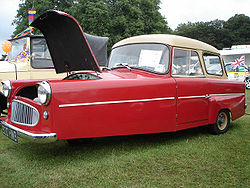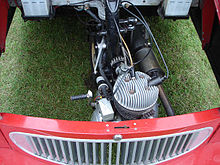Bond minicar
| Bond | |
|---|---|
|
Bond Minicar (1959)
|
|
| Minicar | |
| Sales designation: | Minicar |
| Production period: | 1949-1966 |
| Class : | Microcar |
| Body versions : | Roadster , sedan , station wagon , panel van |
| Engines: |
Petrol engines : 0.12-0.25 liters (2.9-10.3 kW) |
| Length: | 2640-3353 mm |
| Width: | 1448-1575 mm |
| Height: | |
| Wheelbase : | 1575-1727 mm |
| Empty weight : | approx. 200 kg |
| successor | 875 / Ranger |
The Bond Car Ltd. began manufacturing economical three-wheeled passenger cars in 1949, called the Bond Minicar . They were powered by a one-cylinder two-stroke Villiers engine with a displacement of 122 cc. In 1950 the displacement increased to 197 cm³. The body was mainly made of aluminum, some later models also had parts made of GRP . The wagons were very popular in the post-war period.
The minicar was built in different generations; the last was the "Mark G" from 1961. There were convertibles, delivery vans and station wagons. The engine was enlarged, first as a single cylinder to 247 cm³, then as a two-cylinder four-stroke by Villiers to 247 cm³ (available on request in the Mark G). The engines were basically motorcycle engines with built-in gearboxes and therefore were not equipped with reverse gear. But this was only a minor inconvenience, because the engine, transmission and front wheel were bolted into one unit, which could be turned with the steering wheel by 90 ° in any direction, so that the car could be turned within a car's length.
A kind of reverse gear was offered in later models, but you had to stop the engine and start again in the other direction. This was done by the reverse approach of the Dynastart unit.
A total of 24,484 minicars were produced in 12 years.
Minicar Mark A (1949–1951)
The first generation had a self-supporting aluminum body. The rear wheels were not sprung, so the tires provided the only damping. The air-cooled single-cylinder Villiers engine with a displacement of 122 cm³ was mounted on the front suspension and was steered together with it as a unit. At first the steering consisted of steel cables that were wound on spools, later a toothed sector steering was used. The transmission from the motorcycle had three forward gears but no reverse. Only the rear wheels could be braked. The engine had to be started with a kick starter.
The cars were designed as an open two-seater with a single bench. The weather protection was not worth mentioning. The headlights were on arms on the sides of the vehicle. The top speed was 56 km / h.
In 1950 a deluxe version came out, which had a larger engine with 197 cm³ displacement and a windshield made of glass instead of acrylic glass .
One of these open cars was tested by the car magazine “The Motor” in 1949, only carried the driver at a top speed of 69.7 km / h and accelerated from 0 to 50 km / h in 13.6 seconds. The fuel consumption was 3.9 l / 100 km. The test car price was £ 262 including VAT.
Minicar Mark B (1951-1952)
The Mark B finally had an independent rear suspension with coil springs and a 197 cc engine. In addition to the open car, there was also a delivery van.
Minicar Mark C (1952-1956)
The Mark C had a newly developed structure. The headlights were now in the fenders and there was a real door, but only on the passenger side. An electric starter was available on request on the Villiers 8E engine with 197 cm³. There was a larger steering wheel and the cable steering was replaced by a toothed segment steering with which the front wheel with the motor could be swiveled 90 ° to the left or right. This made it possible to turn around with this car within a car length, which compensated for the disadvantage of the lack of reverse gear. These were the minicar's prime; production rose to 100 cars / week in 1955 and a total of 14,000 cars were built in 1956
Minicar Mark D (1956–1957)
The Mark D was a revision of the Mark C. New were the Villiers 9E engine with 197 cm³ displacement and the 12-volt electrical system.
There was a family version with a small hammock-style back seat.
Minicar Mark E (1958-1959)
The last generations of the minicar had a completely new shape. The body, which was still made of aluminum, was mounted on a steel frame. There were doors on both sides now and the cars had four-speed transmissions.
There were now the superstructures “Family” (with emergency seats in the back), “Tourer” (convertible) and “Van” (delivery van), optionally with a GRP roof.
The maximum speed was around 80 km / h.
Minicar Mark F (1959–1961)
The Mark F was similar to the Mark E and had a 250 cm³ engine, with reverse gear on request (function see above). The top speed was 88.5 km / h. For the first time there was also a closed limousine.
Minicar Mark G (1961-1966)
The Mark G had a redesigned body and the windshield moved forward, which made for a larger interior. A rear window in the direction of travel had the same effect in the limousine, which gave the car the appearance of a "real" car. There were even crank windows and lockable doors. A station wagon version was new, and there were different engines to choose from in the late Mark G models: the Villiers 35A single-cylinder with 11.5 bhp (8.5 kW) and the two-cylinder four-stroke engine with 14 bhp (10.3 kW). Semi-hydraulic brakes replaced the old steel cable and rod system of the predecessor, and there were larger 10 ″ wheels.
Web links
Individual evidence
- ^ David Culshaw, Peter Horrobin: The Complete Catalog of British Cars 1895-1975. Veloce Publishing, Dorchester 1997, ISBN 1-874105-93-6 .
- ^ Roger Gloor: All cars of the 50s 1945-1960. 1st edition. Motorbuch Verlag, Stuttgart 2007, ISBN 978-3-613-02808-1 .
- ^ Graham Robson: A to Z of British Cars 1945–1980. Herridge, Devon 2000, ISBN 0-9541063-9-3 .
- ^ The Bond Minicar De-luxe Road Test. In: The Motor. 1949.
- ^ Graham Robson: A to Z of British Cars 1945–1980. Herridge, Devon 2000, ISBN 0-9541063-9-3 .
- ^ N. Georgano: Beaulieu Encyclopedia of the Automobile. HMSO, London 2000, ISBN 1-57958-293-1 .
- ^ Roger Gloor: All cars of the 50s 1945-1960. 1st edition. Motorbuch Verlag, Stuttgart 2007, ISBN 978-3-613-02808-1 .
- ^ Graham Robson: A to Z of British Cars 1945–1980. Herridge, Devon 2000, ISBN 0-9541063-9-3 .
- ^ Graham Robson: A to Z of British Cars 1945–1980. Herridge, Devon 2000, ISBN 0-9541063-9-3 .


